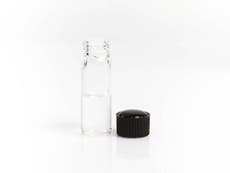GHB should be moved up to Class B, report says
‘There is significant evidence of stigma experienced by LGBT users, currently the predominant users of these drugs’, government advisory body says

Your support helps us to tell the story
From reproductive rights to climate change to Big Tech, The Independent is on the ground when the story is developing. Whether it's investigating the financials of Elon Musk's pro-Trump PAC or producing our latest documentary, 'The A Word', which shines a light on the American women fighting for reproductive rights, we know how important it is to parse out the facts from the messaging.
At such a critical moment in US history, we need reporters on the ground. Your donation allows us to keep sending journalists to speak to both sides of the story.
The Independent is trusted by Americans across the entire political spectrum. And unlike many other quality news outlets, we choose not to lock Americans out of our reporting and analysis with paywalls. We believe quality journalism should be available to everyone, paid for by those who can afford it.
Your support makes all the difference.GHB, a recreational drug that has also been used by murderers and rapists to facilitate their crimes, should be reclassified as a Class B substance, a government advisory body has said.
Citing a “concerning increase” in the harm it causes, the Advisory Council on the Misuse of Drugs (ACMD) called for a reclassification in the substance’s category to bring it in line with certain amphetamines and ketamine.
Short for gamma-hydroxybutyric acid, GHB is currently categorised alongside anabolic steroids and certain tranquillisers.
The drug is used as a recreational party drug – but has also become synonymous with a number of high profile sexual assault and murder cases.
Reynhard Sinaga, the nation’s most prolific rapist who drugged and assaulted more than 40 men, was jailed earlier this year – with the court told he had laced his victims drinks with GHB.
The advisory council also called for related substances, known as GHBRS, to be added to the higher category.
The committee added use of the drug was particular high among the LGBT+ community, as well as in chemsex – the use of narcotics in a sexual setting which has become associated in particular with gay and bisexual men.
Among the recommendations put forward to government by the ACMD is a call for routine testing for GHBRS in unexplained deaths, records to be kept on their use by drug and sexual health services, and funding for analysis of a survey on the sex lives of gay men for at least five years so use of the drug can be looked at over time.
“Given the evidence of significant harms across different contexts, the ACMD have today made a broad set of recommendations on monitoring, legislation, prevention and treatment, which should be taken forward as a whole to reduce harms associated with GHBRS”, Professor Owen Bowden-Jones, chairman of the ACMD which advises the government on drugs, said.
“There is significant evidence of stigma experienced by LGBT GHBRS users, currently the predominant users of these drugs, and these recommendations seek to avoid further stigmatisation and reduce the barriers to treatment for those who need it”.
The ACMD found that since its last report on the substances in 2003, there was “evidence of a concerning increase in the health and social harms among those who use these drugs”.
The report adds “The number of deaths where GHBRS were implicated has also increased since the last report, although these numbers remain low.”
As well as those who knowingly take the drugs, there is “also evidence of harms caused by being unknowingly drugged with these substances”.
“It is currently unclear how commonly this occurs, however there is evidence of serious cases, including robbery, drug facilitated sexual assault and murder,” the report adds.
Additional reporting by agencies

